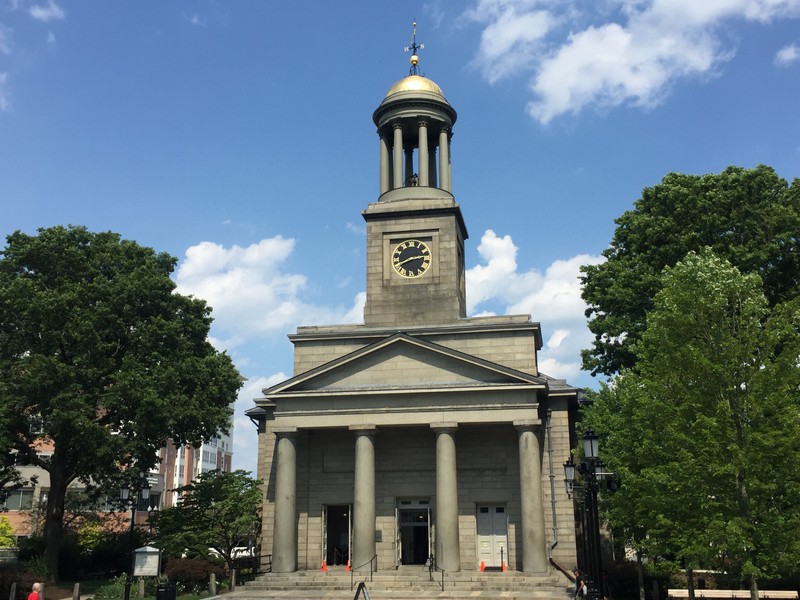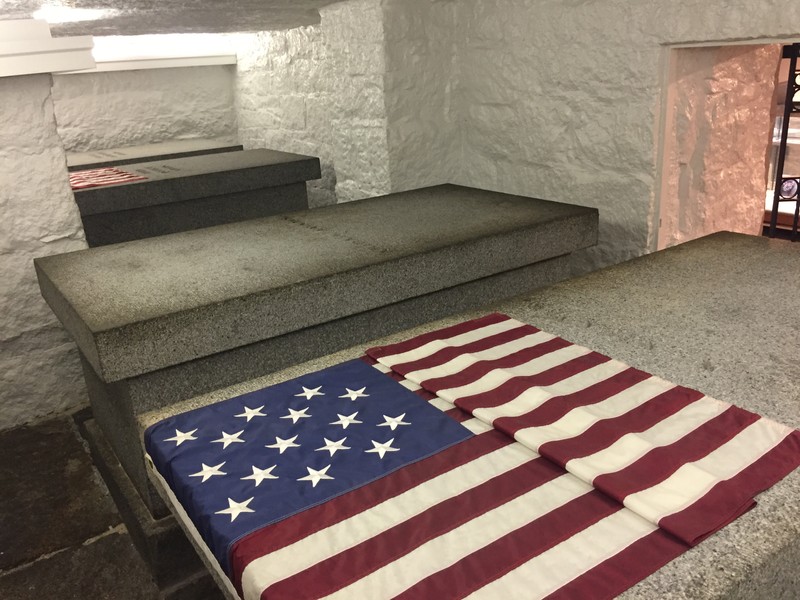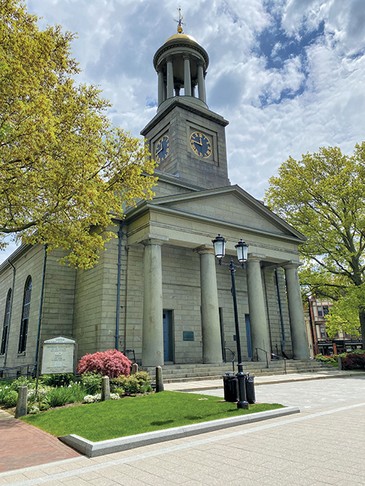Church of the Presidents
Introduction
Text-to-speech Audio
Built in 1828, United First Parish Church is the fourth building to house the community’s earliest congregation (1639) and is the final resting place of the Adams Presidents and First Ladies. Once known as the Old Stone Temple, this National Historic Landmark is considered the finest existing Greek Revival church in New England.
Images
The United First Parish Church, aka the Church of the Presidents

These sarcophagi hold the remains of the Adams presidents and first ladies. From front to back, John Adams, Abigail Adams, John Quincy Adams, and Louisa Catherine Adams.

This plaque denoting the location of the Adams Crypt is affixed to the front of the church.

United First Parish Church, Quincy - Church of the Presidents

Backstory and Context
Text-to-speech Audio
Constructed of Quincy granite, the United First Parish Church is the fourth meeting house of a congregation that was initially gathered as a branch of the Church of Boston in 1636. This house of worship, completed in 1828, is also known as the Church of the Presidents because it once counted U.S. presidents John Adams and John Quincy Adams among its parishioners. These father and son chief executives, along with first ladies Abigail Adams and Louisa Catherine Adams, are entombed in the building’s lower level crypt.
The congregation that occupies the Church of the Presidents was first gathered in 1636 as a branch of the Church of Boston. These Puritan bodies separated in 1639, and the now independent parish became the fifteenth church in the Massachusetts Bay Colony. The establishment of this congregation allowed for the surrounding area to become its own town, and Braintree was incorporated in 1640. In 1792, by which time Braintree had become very populous, the town fragmented into different communities, with its northern precinct becoming the town of Quincy.
Eight generations of the Adams family worshiped as members of the congregation, from English immigrant Henry Adams in its earliest days to Brooks Adams, who died in 1927. The second president, John Adams, was baptized as an infant in 1735 in the Hancock Meeting House, named after its first minister, Reverend John Hancock (the father of the governor and statesman). John Adams and his wife, Abigail, were raised as Congregationalists but remained aligned with the church doctrine as it evolved into a Unitarian body.
Circa 1822, John Adams – by then out of office and in advanced aged – approached local leaders about the prospect of replacing the wooden Hancock Meeting House with a stone temple that could better accommodate the congregation. His idea was well-received, and Adams assisted in the planning. He also donated land from which the granite for the building was to be quarried. Adams died in July 1826, prior to construction, and joined First Lady Abigail Adams in Hancock Cemetery, beside the meeting house. That September, John Quincy Adams – their son, as well as the sitting president – wrote asking permission for his parents’ remains to be removed to the stone temple, which was to be erected next door to the Hancock Meeting House. Their coffins were lowered into their new crypt in April 1828 amid the new building’s construction.
The stone temple was designed by Alexander Parris, who had recently completed Quincy Market in downtown Boston. It is Greek Revival in its style and incorporates elements of both Quincy Market and the Pantheon in Rome. A dedication service was held on November 12, 1828. President John Quincy Adams wrote a hymn for the occasion. He subsequently purchased pew #54 and sat there for services when he was in Quincy. Louisa Catherine Adams, his wife and first lady, attended a local Episcopal church.
John Quincy and Louisa Catherine Adams died in 1848 and 1852, respectively, and were laid to rest in the family tomb at Hancock Cemetery. Their son, Charles Francis Adams, soon arranged for the crypt in the First Parish Church to be expanded, and the sixth president and his first lady were transferred there in December 1852. The crypt beneath the church was private Adams property until 1903, when it was conveyed over to the congregation. It was then open only via appointment until 1976, when the History and Visitors Program began leading daily tours. The church, officially referred to as the United First Parish Church since a merger with the Wollaston Unitarian Society in 1958, was designated a National Historic Landmark in 1971.
Independent from the active congregation, the church’s History and Visitors Program conducts daily tours of the sanctuary and crypt from mid-April until mid-November
Sources
Adams, John. Deeds and Other Documents Related to the Several Pieces of Land and to the Library Presented to the Town of Quincy by President Adams, Together with a Catalog of the Books. Cambridge MA, Hilliard and Metcalf, 1823. p.4.
Adams, John Quincy. (Letter) "To Thomas Greenleaf, Josiah Quincy, Thomas Boylston Adams, Edward Miller, and George W. Beale, Supervisors of the Temple and School Fund given by John Adams late deceased to the Town of Quincy" as quoted in William Churchill Edwards. Historic Quincy Massachusetts. City of Quincy,1957. p.163.
Bennett, Rev. Sheldon W. "United First Parish Church (Unitarian) in Quincy." April 2010.
"Timeline." United First Parish Church Interpretive Resource Manual.
"United First Parish Church." April 2002.
Kurt Deion
Kurt Deion
Kurt Deion
Paula Pecevich
